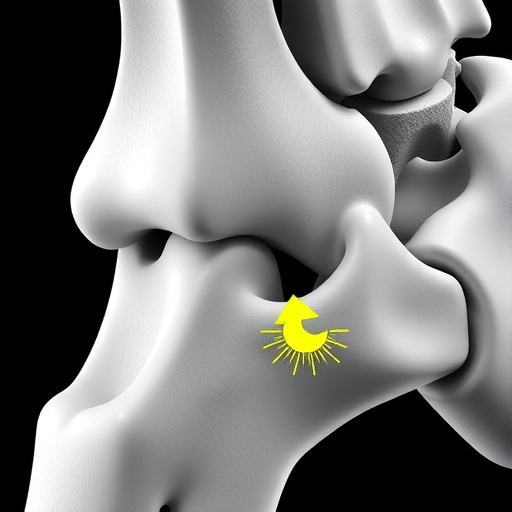In recent advances within regenerative medicine, the biomechanical environment following surgical intervention has emerged as a critical determinant for successful tissue repair. A new investigation published in BioMedical Engineering OnLine delves deep into the influence that post-operative loading regimens have on the regenerative capacity of biomimetic osteochondral scaffolds specifically designed to restore damaged articular cartilage and underlying bone structures. This study encompasses pioneering insights derived from a robust animal model, providing compelling evidence that the modulation of mechanical load post-implantation could dramatically enhance the functional outcomes of scaffold integration and tissue regeneration.
Articular cartilage, a specialized connective tissue facilitating smooth joint articulation, possesses remarkable resilience and deformation capabilities. Despite its robust nature, once damaged due to trauma, degeneration, or disease, it exhibits limited intrinsic repair capacity. Osteochondral defects, which compromise both cartilage and the adjoining subchondral bone, present a particularly daunting challenge in clinical orthopedics. The biomimetic osteochondral scaffolds used in this study replicate the complex zonal architecture and biomechanical properties of native cartilage and bone, aiming to support endogenous tissue regeneration and restore joint function.
To elucidate the effect of mechanical loading after scaffold implantation, the researchers employed an ovine model widely accepted for its translational relevance to human joint physiology. Sixteen adult male sheep underwent surgical creation of osteochondral defects subsequently filled with the biomimetic scaffold. The crux of the investigation was the post-surgical mechanical regimens imposed on the animals, categorized into three: complete immobilization (Group A), controlled partial load bearing (Group B), and unrestricted full load bearing (Group C). This stratification allowed for a systematic evaluation of how differing biomechanical stresses influence tissue healing processes.
Throughout the six-month post-operative period, clinical monitoring and gait analyses highlighted notable disparities between groups. Sheep subjected to partial loading demonstrated markedly improved limb use and absence of limping, contrasting with the limited mobility observed in animals under both immobilization and full loading conditions. These in vivo findings underscore the nuanced role mechanical stimuli play not merely as passive factors but as active regulators of tissue remodeling and functional restoration.
Advanced imaging techniques including micro-computed tomography provided quantitative and qualitative assessments of scaffold integration and osteochondral defect filling. Intriguingly, Group B specimens exhibited superior scaffold incorporation and defect closure featuring tissue characteristics akin to native hyaline cartilage. Conversely, Groups A and C predominantly developed fibrocartilaginous tissue, which lacks the mechanical integrity and biocompatibility required for durable joint function. This suggests that both mechanical under-stimulation and overloading can disrupt the delicate balance facilitating true regenerative healing.
At the subchondral bone level, variations in mineralization and porosity were revealed. Immobilized animals showed elevated subchondral bone porosity, possibly reflecting impaired mechanical signaling and bone remodeling. In contrast, animals exposed to full load had heightened osteochondral mineralization, which may indicate aberrant bone formation or sclerosis detracting from functional joint biomechanics. Controlled partial loading, therefore, appeared to optimize bone-tissue responses conducive to scaffold integration and joint restoration.
Atomic force microscopy offered nanoscale insights into the microstructural composition and surface topology within the regenerated cartilage regions. Partially loaded groups displayed rough, fiber-like surface features consistent with organized collagen networks characteristic of healthy cartilage. Such microarchitectural organization is pivotal for mechanical strength and resilience, reinforcing the notion that mechanical cues influence not only macrostructural phenotype but also the molecular assembly of regenerated tissues.
The cumulative data converges on a paradigm whereby post-operative rehabilitation protocols necessitate finely tuned mechanical loading regimes to maximize regenerative outcomes. The findings illuminate how partial loading acts as a critical mechanobiological stimulus that enhances scaffold functionality, augments tissue quality, and expedites recovery of joint mobility. This represents a seminal step toward personalized, load-guided therapies in cartilage tissue engineering.
Importantly, this research addresses a pivotal gap in understanding how the temporal and magnitude aspects of mechanical stress influence biomimetic scaffold performance. By circumventing the extremes of immobilization and excessive loading, partial load embraces a middle ground that facilitates cellular mechanotransduction pathways essential for matrix synthesis and remodeling. These mechanistic insights pave the way for novel post-surgical rehabilitation strategies tailored to individual biomechanical environments.
Moreover, the use of an established large animal model confers translational validity, bolstering the potential for clinical adoption. This research informs orthopedic surgeons and rehabilitation specialists on optimizing surgical fixation and weight-bearing protocols to harness the regenerative potential of next-generation osteochondral scaffolds effectively.
Future directions may extend toward integrating real-time load monitoring and adjustable support devices, enabling clinicians to calibrate mechanical stimuli dynamically throughout healing phases. This study also inspires exploration into molecular targets activated by mechanical loading, which could be synergistically manipulated to amplify scaffold-guided regeneration.
In summary, the groundbreaking work featured in BioMedical Engineering OnLine accentuates how controlled mechanical loading, specifically a regimen of partial post-operative weight bearing, substantially improves the integration and regenerative efficacy of biomimetic osteochondral scaffolds in a clinically relevant animal model. This research not only reshapes our understanding of cartilage repair biomechanics but also charts a transformative path toward functional joint restoration and improved quality of life for patients suffering from cartilage injuries.
Subject of Research: The effect of post-operative mechanical loading on the regenerative potential of biomimetic osteochondral scaffolds in articular cartilage repair.
Article Title: The post-operative loading regimen influences the regenerative potential of a biomimetic osteochondral scaffold.
Article References:
Cardinale, U., Pulino, A., Filardo, G. et al. The post-operative loading regimen influences the regenerative potential of a biomimetic osteochondral scaffold. BioMed Eng OnLine 24, 120 (2025). https://doi.org/10.1186/s12938-025-01377-6
Image Credits: AI Generated




